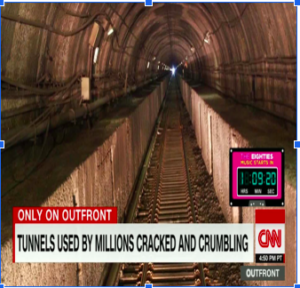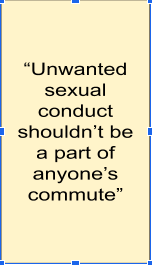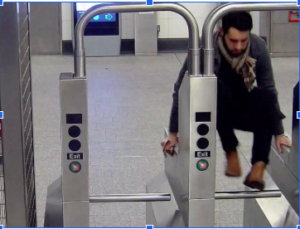Aboubakr Abdulsamed
Professor Skelly
English 110
October 17, 2019
Inquiry Based Essay Final Draft
“You can’t understand a city without using its public transportation system.” Public transportation is a big part of our lifetime, especially in New York City. New York City is the most populous city in the United States. The New York City subway system or the Metropolitan Transportation Authority (MTA) has become a part of our daily life since people are reliant on the subway system for commuting to different places within the city. The MTA train tracks and bus routes run through Manhattan, Queens, Brooklyn, Staten Island, and the Bronx, unifying all five boroughs and improving the lives of everyone. People have different opinions on the MTA since the subway system is broken. There are several delays with outdated infrastructure and faulty technology. Which have brought the famed public transportation system to a grinding halt.
There are different questions that need to be answered. First, How delayed trains affect your daily job? How sexaul harassment affect the public transit system? And How have subway failures in the past contributed to fare evasion, and does this have an effect on the MTA’s ability to fix the subway system?
Why Your Public Transportation Sucks?
Public transportation has never been worse. It’s destroying everybody’s life, and it’s a disaster. People are noticing cracks in the  subway’s crumbling infrastructure during their commute. Insufficient funding has left public transit systems outdated. Public transportation is so important in our daily life, to get to jobs, education, healthcare, and food. According to the American Society of Civil Engineers recently gave our transportation a D minus. It is the lowest grade of any US infrastructure. Due to terrible service and lack of funding, ridership fell in nearly every major city, including the MTA in NYC, where people depend on transit. Therefore, people all over the country are choosing cars over transit. American spend 70 billions hours driving every year, that is an increase of 8 percent from 2014. Also, Americans travel 3.2 trillion miles on American’s roadways. Which is an increase of 12 billion miles from last year.
subway’s crumbling infrastructure during their commute. Insufficient funding has left public transit systems outdated. Public transportation is so important in our daily life, to get to jobs, education, healthcare, and food. According to the American Society of Civil Engineers recently gave our transportation a D minus. It is the lowest grade of any US infrastructure. Due to terrible service and lack of funding, ridership fell in nearly every major city, including the MTA in NYC, where people depend on transit. Therefore, people all over the country are choosing cars over transit. American spend 70 billions hours driving every year, that is an increase of 8 percent from 2014. Also, Americans travel 3.2 trillion miles on American’s roadways. Which is an increase of 12 billion miles from last year.
Sexual Harassment on Public Transport
Sexual Harassment is an action can be done by men and women, which is related to unwelcome behavior on sex. These  inappropriate behaviors toward women may violate their fundamental rights and dignity which is associated with mild to severe health consequences. Harassment of someone because of that person’s sex, gender identity, or sexual orientation is prohibited on the MTA bus, subway and commuter railroad network. In addition, victims, while using public transportation, tend to have a fear of getting sexually harassed, and this has caused women to modify their travel routes or restrict their use of public transport at all. According to an article called “Study Finds Alarming Number of Sexual Harassment on Subway” there has been a high number of New Yorkers that are victims of sexual harassment or assault in the New York City subway system. Many of the crimes were unreported by victims or witnesses. Many people who are victims of sexual harassment are not fighting back, instead they have become
inappropriate behaviors toward women may violate their fundamental rights and dignity which is associated with mild to severe health consequences. Harassment of someone because of that person’s sex, gender identity, or sexual orientation is prohibited on the MTA bus, subway and commuter railroad network. In addition, victims, while using public transportation, tend to have a fear of getting sexually harassed, and this has caused women to modify their travel routes or restrict their use of public transport at all. According to an article called “Study Finds Alarming Number of Sexual Harassment on Subway” there has been a high number of New Yorkers that are victims of sexual harassment or assault in the New York City subway system. Many of the crimes were unreported by victims or witnesses. Many people who are victims of sexual harassment are not fighting back, instead they have become  afraid, ashamed, and believe nothing can be done to stop it. Increasing sexual harassment in public transportation will no be good economically. Many people will start to not take the MTA in New York City, which will cause the MTA to raise their fare. Therefore, many people will start not taking public transportation, which will lead to public transportation to decrease in it quality every year. However, there are various ways to intervenue safely and reduce risks. We can make our public transportation system safer one action at a time, but too often people feel helpless when they witness improper sexual conduct.There are various ways to make public transportation safer for people, and not plant a fear into them. One way is to Increasing NYPD presence on subway trains and in subway stations. Also, launching an ongoing public awareness campaign to educate riders about the risk of sexual harassment and assault in the subway system.
afraid, ashamed, and believe nothing can be done to stop it. Increasing sexual harassment in public transportation will no be good economically. Many people will start to not take the MTA in New York City, which will cause the MTA to raise their fare. Therefore, many people will start not taking public transportation, which will lead to public transportation to decrease in it quality every year. However, there are various ways to intervenue safely and reduce risks. We can make our public transportation system safer one action at a time, but too often people feel helpless when they witness improper sexual conduct.There are various ways to make public transportation safer for people, and not plant a fear into them. One way is to Increasing NYPD presence on subway trains and in subway stations. Also, launching an ongoing public awareness campaign to educate riders about the risk of sexual harassment and assault in the subway system.
How Fares affect people to Take Public Transportation
Public transportation fare increases in its price in every few years. In the early 2000s, the MTA fare was one dollar and fifty cents, now in 2019, the MTA fare is two dollars and seventy-five cents. According to an article called “ Long Stable, MTA Fares are Headed Up” written by John Kiernan, the MTA increased its fare by almost 100 percent over the past twenty years. Over the years, the MTA has suggested several levels of increases. The subway fare could rise either 25 cents or 50 cents. The base fare for coin-on-bus and pay-per-fare MetroCard will remain at two dollars and seventy- five cents while 30- and seven-day passes will increase to $121 and $32, respectively, from $116.50 and $31. The bonus on pay-per-ride MetroCard will drop from 11% to 5% with the purchase threshold remaining at $5.50. When fewer people use the MTA, it makes less money, which means it either  needs to cut service or increase fares. This results into fewer people using public transportation, which makes even less money. This means they have to increase its fares and worse service. Nowadays many people use public transportation, especially the MTA, by not purchasing a ticket, which is called fare evasion. People who are caught by the NYPD during fare evasion will be fined 100 dollars.
needs to cut service or increase fares. This results into fewer people using public transportation, which makes even less money. This means they have to increase its fares and worse service. Nowadays many people use public transportation, especially the MTA, by not purchasing a ticket, which is called fare evasion. People who are caught by the NYPD during fare evasion will be fined 100 dollars.
How Investment in Public Transportation Boosts the Economy
The local economy would benefit from a large scale transportation project due to thousands of construction and equipment manufacturing jobs. According to an article from a newspaper called “How Investment in Public Transportation Boosts the Economy”, people spend 232 billion dollars over 10 years, eventually they will spend 928 billion dollars in economic activity over the next 20 years. Cities large and small rely on public transportation to help workers get to their jobs. According to the article, the growing number of workers in the United States needs an increasing capacity to get to work every day, and the less time spent on commuting, the more time is spent on work. So 1 billion investment in public transportation would result in more than 50,000 jobs.
How Subway Delays Affects the Economy and People’s Daily Lives?
According to a magazine article called “NYC Comptroller: Subway delays could cost city $400M a year” written by Chip Barnet. In this magazine, Chip Barnet describes how delays of the subway can affect our economy. Chip Barnet mentioned “New York City’s economy could wind up taking an almost $400 million a year hit from subway delays, according to an economic analysis released by City Comptroller Scott Stringer on Sunday.” This can create financial problems in not only New York City but the whole country. Delays and wait times for trains can cost the economy a lot of money. The five subway lines that most negatively impacted economic activity are the 5, 7, A, F and 4 trains. The 5 train impacted the economy with an average of 21.8 million dollars annually; the 7 train impact the economy with an average of 21.35 million dollars annually; the A train impact the economy with an average of 19.8 million dollars annually; the F and the 4 impact the economy with an average of 19.1 annually. Combined the worst-case economic impact of delays on these five lines tops $140 million. That is a whole lot of money. Subway service has gotten so bad people, that the city workers are walking or biking to work when possible. However, about 18 percent of people who were delayed by the train have been reprimanded for tardiness at work, about 13 percent of riders lost wages and 2 percent were fired because of subway delays. They need to fix the subway to refine the quality of people’s lives and the economy. It’s a must, not a choice.
NYC Public Transit (MTA)
New York City is one of the major cities in America. New York City contains of five cities. The cities are Queens, Brooklyn, Bronx, Manhattan, and Staten Island. New York City has its own public transit called Metropolitan transit authority or the MTA. It’s a public benefit corporation. It is an easy way to get around a city, especially for tourists. Many people like using public transportation but over the years the service start getting worse and worse. One problem in the MTA is fare evasion. Many people take trains without purchasing a ticket, they either jump over the turnstile or open the emergency door. Nowadays people can be fined a hundred dollar ticket by the New York Police Department if they got caught fare evading. Sometimes the NYPD take it to another level and might arrest that person. According to James Smith, an employee at one of the subway station, he has seen many people jumping the turnstile and not getting a ticket. There is only a few people who are caught by the NYPD because there is not a lot of police at the station. He wants to increase the amount of police in each station so people stop fare evading. Due to fare evasion, the system start making less money, which means they either needs to cut service or increase fares. This results into fewer people using public transportation, which makes even less money. This means they have to increase its fares and worse service.
Overall, public transportation is one of the best ways to get around town. Taking public transportation have different outcomes. The positive outcome is investment. A lot of people use public transportation nowadays, which means they spend a lot of money. In the next couple of years, people will spend over 928 billion dollars. This means public transit will get better over the years. 1 billion investment in public transportation would result in more than 50,000 jobs. Also, taking public transportation can reduce the number of people who drive on the highway, which means it will lower traffic jams and improve road condition. Taking public transportation can reduce air pollution. Public transportation can accommodate a lot of people and send them to various destinations. It leads to the reduction of harmful emission gasses such as carbon dioxide. However, there is a negative outcome which make people dont take public transportation. There has been a high number of New Yorkers that are victims of sexual harassment or assault in the New York City subway system. Many people who are victims of sexual harassment are not fighting back, instead they have become afraid, ashamed, and believe nothing can be done to stop it. This makes people feel unsafe, which they stop taking the subway. This is bad for the economy. “If you see something say something”(MTA)
Jordan, Partrick. “Custody of the Eyes.” Study Finds Alarming Number of Sexual Harassment on Subway, Vol. 132, Iss 17, 2005, PP. 25-26.
Krisberg, Kim. “Public transit helps lower obesity rates.” The Nation’s Health, Vol. 49, Iss. 3 May 2019, p. 13.
Kiernan, John. “Long stable, MTA fares are headed up.”Long Island Business News, Vol. 49, Iss 54, 2002, pp. 39A.
“How investment in public transportation boosts the economy.” UWIRE Text, 1 Aug. 2019, p. 1.
Barnet, Chip. “NYC Comptroller: Subway delays could cost city $400M a year.” The Bond Buyer, 3 Oct. 2017.
“Why Your Public Transportation Sucks.” Patriot Act with Hasan Minhaj, season 4, episode 4, 18 August. 2019. Netflix, https://www.netflix.com/watch/80991186
Vowinkel, Patricia. “Federal terror insurance act benefits New York’s MTA: a small premium gives transportation agency $1 billion worth of coverage.” Risk & Insurance, Vol. 14, Issue 5, 2003, pp. 48+.
Smith, James. Personal Interview, 26 October, 2019


